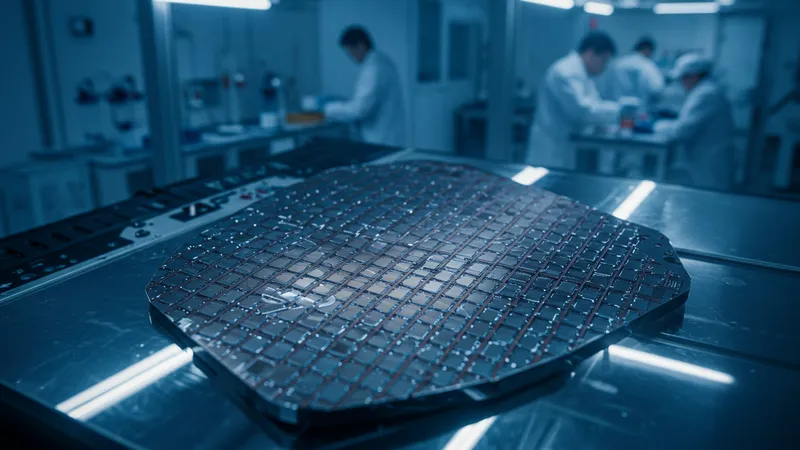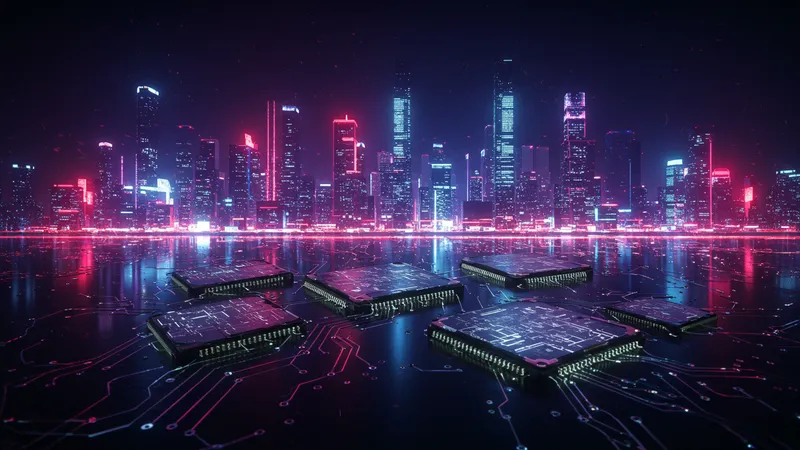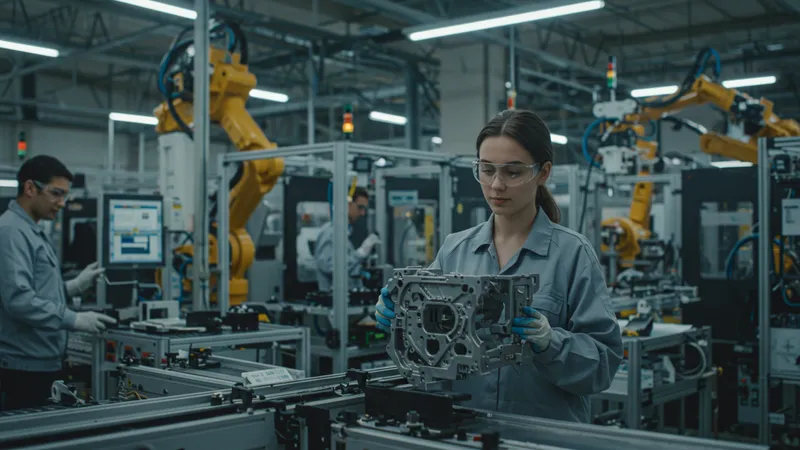Imagine a world where your smartphone charges in seconds, electric cars go hundreds of miles on a single charge, and your home sustainably powers itself. The secret behind these technological leaps? Semiconductors. And their significance is only beginning to emerge.
With renewable energy and smart devices becoming central to daily life, understanding semiconductors is crucial. These tiny yet powerful components are revolutionizing industries. But what makes them indispensable in the race for innovation? You'd be surprised by some of the tools leading this charge.

Semiconductors are not just improving everyday electronics but are also critical in tackling global challenges. For instance, they play a key role in energy-efficient technologies, drastically reducing power consumption across devices. The 5G network, promising unparalleled connectivity speeds, hinges on semiconductor advancements. But that’s not even the wildest part...
Industries are investing billions in semiconductor research, eyeing possibilities that could redefine modern life. From artificial intelligence to space exploration, the potential seems limitless. Semiconductor innovation is accelerating at an extraordinary pace, but the true magnitude of its impact is just unfolding. What happens next shocked even the experts…
Most people haven't even considered how critical semiconductors have become to everyday technology. These small yet mighty components serve as the brain in countless electronics from smartphones to cars. They're the reason your laptop wakes without delay and your phone handles multi-tasking effortlessly. Yet, the journey of semiconductors is just beginning. But there’s one more twist...

The semiconductor industry is poised to shift significantly with the advent of quantum computing. Quantum processing units (QPUs) could make current CPUs and GPUs obsolete, executing complex calculations exponentially faster than today's fastest chips. How this shift plays out could change computing paradigms forever. But there’s more to the transformation...
Amidst the semiconductors' impact on tech, environmental implications cannot be ignored. Innovations promise greener manufacturing processes and cleaner energy solutions. Not only does this lessen environmental impact, but it positions semiconductors as allies in sustainable tech growth. What comes next might truly redefine the tech-industry's approach.
But technological advancements aren't without their challenges. Where there's potential for progress, there's also potential for disruption. New material scarcity and geopolitical issues could alter supply chains and limit tech production. But what you read next might change how you see this industry forever.
Semiconductors are at the heart of exponential technological growth. They're essential for the functioning of critical systems—from healthcare tech innovations to aerospace ventures. Semiconductor components have even enabled 'smart cities,' where interconnected infrastructure streamlines urban living. But what happens when cities get even smarter?

These components are vital for revolutionary AI technology, accelerating machine learning applications that augment decision-making processes in sectors like healthcare, finance, and security. With AI making split-second judgments quicker than any human, the implications are profound. What emerges next could redefine human interaction with technology forever.
Then there's IoT (Internet of Things), which directly benefits from semiconductor advances by connecting billions of devices globally. Network efficiencies continue to improve, thanks to these tiny components allowing seamless device communication. The true impact of this connectivity is still unfolding. But there’s one more twist...
The semiconductor innovation has also led to advanced user interfaces, transforming how humans interact with machines. Through adaptable touchscreen tech to voice recognition, the human-tech interaction is enhanced more than ever before. What you'll read next might change perception of user experience design forever.
The semiconductor industry's rapid growth does not come without its share of costs. Significant consumption of rare materials and energy in manufacturing has raised concerns. The less visible impact includes e-waste challenges and the carbon footprint left by outdated components. But beyond these are more profound economic implications that are often overlooked...

The global supply chain is under tremendous strain due to increasing demand. A slight disruption in the availability of semiconductors can lead to downstream bottlenecks affecting multiple industries—from automobiles to consumer electronics. The reliance on specific geographic areas for raw materials makes this an urgent issue to address. But there's another surprising development...
Competition also drives up production costs significantly. The fierce race to develop the next breakthrough semiconductor technology involves massive investment in research and infrastructure. This competition can lead to innovation simultaneously driving expenses higher. What comes next could make these stakes even more critical.
Looking ahead, eco-friendly initiatives promise to minimize these costs. Technological advancements aim to reduce raw material consumption and improve waste management. Seeing how the industry balances growth with responsibility will be a narrative to watch. But what lies ahead could shift priorities in unexpected ways.
Traditional silicon might be reaching its physical limits, leading researchers to explore novel materials. Innovations such as graphene and gallium nitride are reshaping semiconductor capabilities, offering faster, more efficient, and smaller components. But these materials come with their own sets of challenges...

Graphene, for example, is celebrated for its strength and electrical properties. Yet, the challenge lies in the production phase, where creating large, defect-free sheets remains costly and complex. As research continues to overcome these barriers, the potential rewards promise to be transformative in electronics engineering.
Meanwhile, gallium nitride is driving significant progress in power electronics, offering higher efficiency and faster switching speeds than silicon. It's already making waves in consumer electronics and lighting applications, drastically lowering energy consumption. The next development in this area could truly electrify the industry.
The search for even more adaptive materials is in full swing. As researchers push the boundaries, new discoveries could dwarf previous innovations. What you discover on the next page might change your entire outlook on material sciences forever.
Those working inside the semiconductor industry have a front-row seat to the evolution of tech. Engineers and scientists are continually pushing the envelope, overcoming seemingly impossible challenges to advance the industry. The tools of tomorrow are being built today in high-tech labs across the world.

It's a realm where collaboration often spans continents, with talent pooled from all corners of the globe. Yet, this level of international cooperation isn't without its obstacles, from time zones to political tensions. How these professionals manage remains a story of intrigue and ingenuity. But there’s another twist...
Certain operations inside the industry remain shrouded in mystery due to proprietary secrets and competitive edge. While public announcements herald breakthroughs, much occurs in guarded labs, where even minute details can make a big difference. What's concealed within these frameworks could revolutionize how we understand semiconductors.
Innovation is accompanied by a need for secrecy, protecting intellectual property while remaining at the forefront of development. The next innovative jump could emerge from an unexpected sector entirely. And what you'll uncover next could change global technological strategies at their core.
As semiconductor technology advances, education must keep pace. There's a growing gap between industry needs and the skills taught in academic institutions. Bridging this divide is crucial for future workforce readiness, demanding a reimagining of educational models.

STEM programs are incorporating more semiconductor-focused courses, fostering deeper understanding and practical experience. But the challenge lies in equipping educators with the latest knowledge themselves. Few truly grasp how rapidly these technologies evolve, which creates a disconnect with what's professionally required.
Many institutions are partnering with industry leaders to inject real-world knowledge into the curriculum. These partnerships offer insights and lab access that are invaluable for students. The collaboration transforms traditional education into a robust, up-to-date learning environment. There's more to these developments than meets the eye, though.
The momentum doesn't stop with universities. Online platforms and boot camps are emerging as popular alternatives. They provide just-in-time learning and skills, tailored to immediate industry demands. Discovering how these programs evolve might redefine continuous learning approaches forever.
As semiconductor production ramps up, so does the focus on its environmental impact. Companies are seeking greener processes, aiming to reduce both carbon emissions and resource usage. From water conservation methods during production to sustainable energy sources, the industry is in a green transition.

Leading manufacturers have begun adopting cleanroom environments that optimize resource efficiency while maintaining quality. Water recycling in semiconductor fabrication plants is becoming a standard practice. These processes safeguard the environment and significantly cut manufacturing costs—an industry-wide win-win.
Another remarkable shift is the increased use of recyclable materials. This focus aims to tackle e-waste at its source by ensuring components can be easily recovered and reused at the end of their lifecycle. The systemic change promises an entirely new way of material management.
Long-term, the transition to sustainability will redefine competitive advantage. Those companies lead with transparency and commitment likely to set benchmarks and shape the industry's ecological standards. The upcoming strategies might change not only how the industry functions but how others follow suit.
The role of semiconductors in powering the future of technology is as exciting as it is essential. With every advancement, these unassuming components promise to unlock possibilities beyond our current imagination. As innovation continues at this accelerated pace, understanding these dynamics helps us prepare for a future reshaped by technology. As we reach the conclusion, transform your newfound insights into action. Discuss these advancements within your networks, bookmark this journey for future reference, and share your curiosity with others. The narrative of semiconductors is a story still being written—won’t you be part of it?